If your Outlook exported PST file appears to be empty, read this post to learn how to fix the issue. Many users have reported that when they open a PST file in Outlook, it appears empty (no emails or contacts are visible), even though the file size suggests it contains data. A few have also reported that when they search for specific content, Outlook can find and display the missing emails.
![Outlook Exported PST File Empty [Fix] Outlook Exported PST File Empty [Fix]](https://www.thewindowsclub.com/wp-content/uploads/2025/03/Outlook-Exported-PST-File-Empty-Fix.jpg)
The issue is most commonly reported in Microsoft Outlook versions that use Cached Exchange Mode and rely on Microsoft Exchange or Office 365 accounts. If you’re also experiencing this issue, keep reading to learn how to fix it.
Fix Outlook Exported PST File Empty
If your Outlook exported PST file appears empty, ensure that the required folders are fully cached before attempting the export. Emails stored only on the Exchange server (and not locally cached) will not be included in the PST file. If the issue persists, follow these troubleshooting steps:
- Reset the View Settings
- Disable any filters
- Repair the PST File
- Use MFCMAPI to change folder properties
- Manually export emails to PST
Let us see this in detail.
1] Reset the View Settings

If you’ve accidentally changed the View Settings in Outlook, your PST folder content may appear missing. Resetting the View Settings restores the default folder display, making emails appear again if they were hidden due to sorting issues or custom view settings.
Open Outlook and navigate to the folder that appears empty. Click on the View tab in the top ribbon. Select Change View > Compact > Apply Current View to Other Mail Folders (compact is the default view in Outlook for most mail folders). Click Yes when prompted.
Close Outlook and reopen it to see if the emails appear. If they still don’t, select View > Reset View.
2] Disable any filters
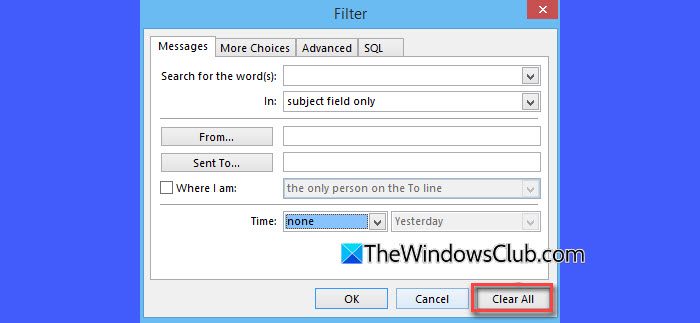
Filters can make a PST file appear empty if they hide all emails based on specific criteria. For example, if the unread filter is applied, it only shows unread emails; and if all emails are read, the folder looks empty. Check and disable filters and see if it fixes the issue.
Click the View tab. Click View Settings > Filter.
If any filters are applied, click Clear All or manually remove them. Click OK and Apply the changes.
3] Repair the PST File
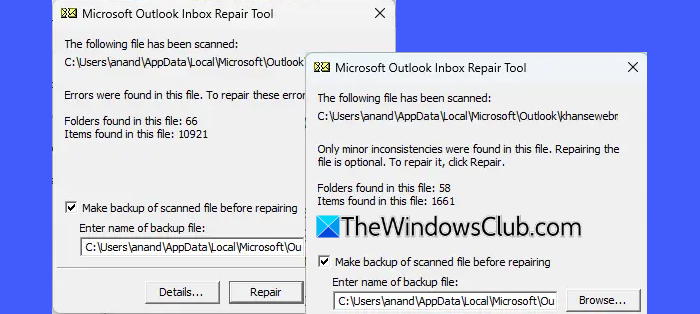
PST file corruption can be a major reason why Outlook behaves abnormally or why the PST file appears empty. Outlook has a built-in tool called ScanPST.exe (Inbox Repair Tool) to fix such issues.
Close Outlook and navigate to the folder where ScanPST.exe is stored.
For Outlook 2021/2019/2016/2013, go to:
C:\Program Files\Microsoft Office\root\OfficeXX\SCANPST.EXE
For Outlook 2010, go to:
C:\Program Files (x86)\Microsoft Office\Office14\SCANPST.EXE
For Microsoft 365, go to:
C:\Program Files\Microsoft Office\root\OfficeXX\SCANPST.EXE
Run ScanPST.exe as Administrator. Click Browse and select your PST file. Click Start to scan for errors.
If errors are found, click Repair. Once completed, restart Outlook and check if the emails are restored.
Note: You can also use third-party tools to repair corrupt Outlook PST files. However, always backup your PST file before such tools, as they may alter the original file.
4] Use MFCMAPI to change folder properties
MFCMAPI is a low-level troubleshooting tool that provides deep access to Outlook’s data store, allowing you to fix issues that can’t be resolved through the Outlook interface.
Note: MFCMAPI directly modifies Outlook’s data store. Incorrect changes can cause data loss or corruption. Back up your PST file before making any modifications and proceed with caution.
Download MFCMAPI from the official Microsoft site by clicking here. Extract and run MFCMAPI.exe.
Click Session > Logon and select your Outlook profile. Locate your PST file under the Store List and double-click to expand it.

Navigate to IPM_SUBTREE for IMAP-based PST files (or Root Container if using a different PST type ). Locate the affected folder and select it.
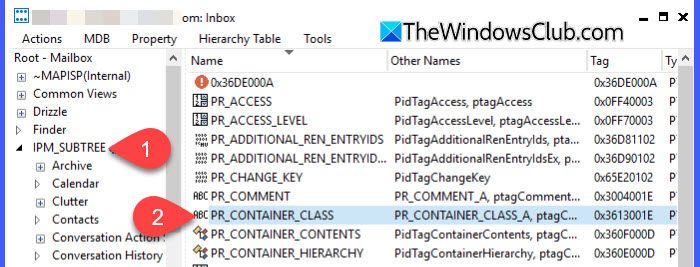
Look for PR_CONTAINER_CLASS in the properties list. Double-click it, change IPF.Imap to IPF.Note, and click OK to save changes.
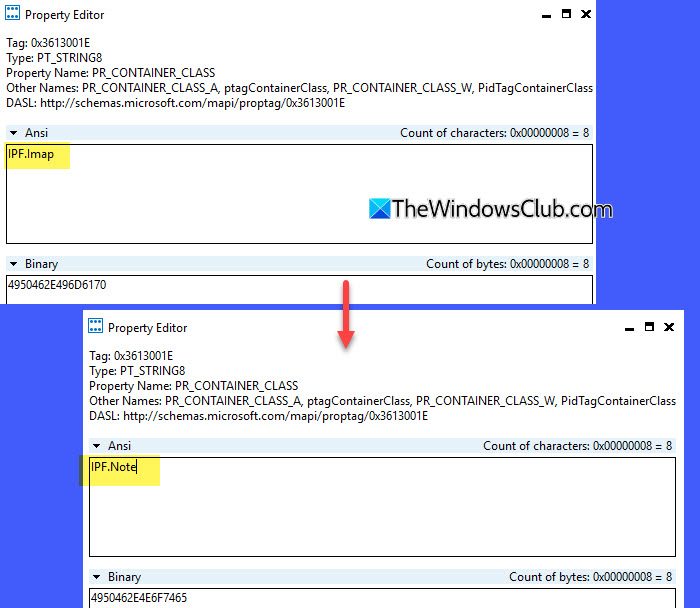
Repeat the above steps for each affected folder. Then, close the window and click Logoff under Sessions on the main screen.
Restart Outlook. The folder should now display emails correctly.
5] Manually export emails to PST
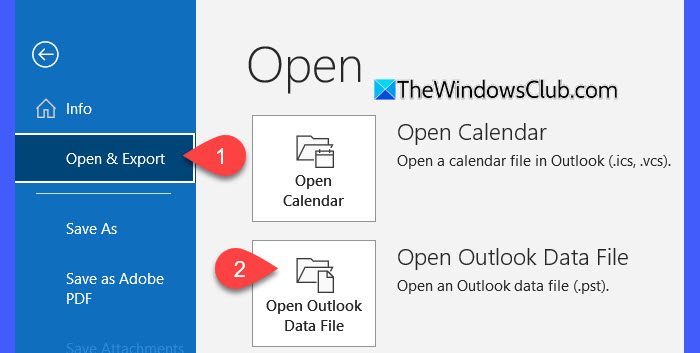
Manually exporting emails to PST ensures that all emails, including those stored only on the Exchange server (not locally cached), are fully moved into the PST.
Go to File > Open & Export > Open Outlook Data File and load the empty PST.
Navigate to the folder you want to export (e.g., Inbox). If using Cached Exchange Mode, Outlook may not have downloaded all emails locally. Click “Click here to view more on Microsoft Exchange” to force Outlook to load all server-stored emails. Look at the bottom-left corner of Outlook to note the total item count.

Next, select all emails (Ctrl + A). Right-click > Move > Other Folder…. Navigate to the PST you opened and click OK to start the process. Avoid using Outlook or interrupting the process. After completion, verify that the email count matches.
I hope this helps.
Read: How to set up Auto Archive in Outlook.
How do I recover a lost Outlook PST file?
If you’ve lost your Outlook PST file, check the default Outlook PST location or search for it manually using File Explorer. To verify its path, open Outlook and navigate to File > Account Information > Account Settings > Data files tab to locate the missing PST file. If the file is found but corrupted, use ScanPST.exe to repair it. If the PST file was accidentally deleted, try recovering it using Windows File Recovery or third-party tools like EaseUS Data Recovery Wizard.
How to check if a .PST file is corrupted?
Outlook includes a built-in tool called Inbox Repair Tool to check for and repair PST file corruption. It scans the PST file for inconsistencies, errors, and structural issues, and then attempts to fix them automatically. If Outlook is crashing, displaying missing emails, or showing error messages, running the tool can help restore the file and recover lost data.
Read Next: Your mailbox is almost full Outlook 365 message.